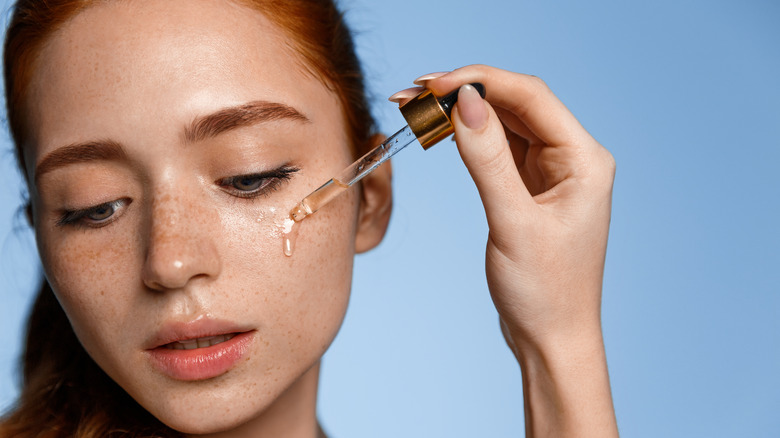Can The Retinol Sandwiching Skincare Trend Really Help Reduce Redness?
Retinol is a sought-after skincare ingredient because of its long list of proven benefits. Those who swear by retinol have found that it not only clears their pores and diminishes the look of wrinkles, but many have also seen improvements in their skin's elasticity and complexion. Since your skin absorbs vitamin A in retinol, it works by increasing the production of skin cells and boosting natural collagen. This regenerates blood vessels and helps brighten your skin's overall appearance, Cleveland Clinic explains.
However, retinol can also be powerful which leads many to give it up in the beginning, before experiencing any of the benefits. If you have started integrating retinol into your skincare routine and noticed an increase in redness or painfully dry skin, don't panic. This is a very common occurrence as your skin adjusts to a new and effective ingredient.
It's actually recommended to start using retinol three to four times a week so that your skin can adjust to the increase in cell turnover. However, retinol can become a part of your nightly skincare routine over time, and a lot happens to your face when you start using retinol every day. Plus, the way you sandwich retinol products into your skincare lineup can help you reduce your skin's redness.
Give your skin time to change
The term "skin purging" may sound scary, but it's actually a really satisfying thought once you understand it. As new skin cells are rapidly replaced, the oil and dirt clogging your pores begin to rise to the surface. While this may temporarily cause your skin to look more irritated, it's actually helping to clear your skin from the inside out.
During this process, you may see an increase in dry skin and redness, which never feels like a good sign with a new product. Understanding why your skin reacts to retinol in certain ways can help you mitigate the effects. Since your skin is quickly shedding dead skin cells and replacing them with new ones, it's common to experience flaky skin before seeing the benefits.
While "retinol sandwiching" may have gained popularity through social media trends, it's also backed by evidence. To combat the drying effects of retinol, sandwiching this product in between two of your favorite moisturizers can help you create the perfect barrier.
Understand your skin's resilience
Retinol sandwiching can be a great option for you if you have sensitive skin. Applying a thin moisturizer on your clean face before retinol will lessen the harsh effects while keeping many of the benefits and minimizing dryness or redness. Sealing in your retinol with a thicker moisturizer is recommended for everyone at the end of their skincare routine since it works to keep your skin hydrated throughout the night.
While moisturizing should feel like second nature in your skincare routine, there are some skincare products you shouldn't mix with retinol. It is good to understand your skin type to ensure you're using the most effective products. If you feel like your skin often withstands new ingredients without getting overly irritated, you may choose to skip the initial moisturizing step and go straight for the retinol, which will give you a more potent effect.
You can also adjust based on how your skin is reacting. If you begin to see redness after applying retinol, the sandwiching method may be right for you since it really helps to combat that inflammation. Some people mix their retinol with a light moisturizer for extra hydration. Ultimately, the process is customizable but having a go-to moisturizer or two is important. Plus, if you are nervous about adding retinol to your skincare routine, relying on good moisturizers before and after can help ease your mind.

